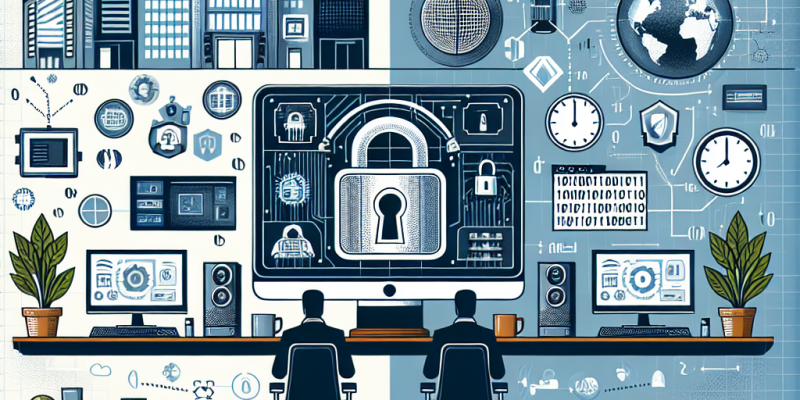Securing Remote Work: Best Practices for a Hybrid Workforce

As organizations adapt to the evolving landscape of work, the hybrid model has emerged as one of the most favored approaches. This model allows employees to split their time between remote work and in-office attendance, promoting flexibility and work-life balance. However, it also introduces unique cybersecurity challenges that organizations must navigate to protect their valuable data and maintain operational integrity. This article explores best practices for securing remote work in a hybrid workforce.
Understanding the Challenges of Hybrid Work
The transition to hybrid work has blurred the lines between professional and personal environments. Employees access corporate resources from diverse locations, making traditional security measures insufficient. Challenges include:
- Increased Attack Surface: With employees using personal devices and home networks, the potential for cyberattacks such as phishing, malware, and data breaches grows.
- Incomplete IT Oversight: IT teams may lack visibility into remote work environments, resulting in unmanaged software and devices.
- Variable Cyber Hygiene: Employees may not follow rigorous cybersecurity practices at home as they would in the office, increasing vulnerabilities.
Best Practices for Securing Remote Work
To safeguard against these risks, organizations need to implement a comprehensive security strategy tailored to a hybrid workforce. Here are best practices to consider:
1. Establish a Robust Remote Work Policy
Develop a clear policy that outlines expectations for remote work, including acceptable use of company resources, guidelines for device management, and reporting procedures for suspicious activities. Communicate these policies regularly and during onboarding sessions to ensure all employees understand their responsibilities.
2. Implement Strong Authentication Protocols
Adopt multi-factor authentication (MFA) to add an extra layer of security beyond passwords. This additional authentication step significantly reduces the risk of unauthorized access, even if passwords are compromised. This can include biometrics, OTPs (one-time passwords), or authenticator apps.
3. Utilize Virtual Private Networks (VPNs)
Encourage employees to connect to the company’s network using a secure VPN. A VPN encrypts data transmitted between the employee’s device and the company server, making it more difficult for attackers to intercept sensitive information.
4. Regularly Update Software and Devices
Ensuring that all software, operating systems, and applications are updated to the latest versions is crucial for security. Regular updates fix known vulnerabilities and bugs, minimizing the chances of exploitation. Consider implementing an automated update system to simplify this process.
5. Educate Employees on Cybersecurity Awareness
Conduct regular training sessions on identifying phishing attempts, safe browsing practices, and the importance of password security. Employees are often the first line of defense against cyber threats, so empowering them with knowledge and skills is imperative.
6. Monitor and Manage Devices
Leverage endpoint security solutions to monitor devices connected to the corporate network. Implement solutions that allow for remote wipe capabilities, ensuring that sensitive data can be erased if a device is lost or stolen. This helps protect the organization from potential data breaches.
7. Conduct Regular Security Audits and Assessments
Regular security assessments and audits help identify vulnerabilities within your hybrid work environment. Penetration testing and vulnerability assessments should be performed to uncover weak points in the infrastructure. Understand that security is not a one-time effort but an ongoing process.
8. Adopt Secure Collaboration Tools
Choose collaboration tools that are secure and compliant with industry regulations. Solutions should feature end-to-end encryption and allow for controlled access to sensitive documents. Ensure that employees are trained on how to use these tools effectively and securely.
9. Implement Zero Trust Architecture
Adopting a Zero Trust approach means that no one, whether inside or outside of the organization, is automatically trusted. Every access request should be verified, regardless of the user’s location. Implement strict access controls and limit user privileges to only what is necessary for their role.
10. Develop Incident Response Plans
Prepare for potential security incidents by developing a comprehensive incident response plan. This plan should outline the steps to take when a breach occurs, including identification, containment, eradication, recovery, and communication strategies. Regularly review and update this plan to ensure its effectiveness.
Conclusion
Securing remote work in a hybrid workforce requires a proactive and multifaceted approach. By implementing best practices tailored to this new work environment, organizations can mitigate risks, empower employees, and foster a culture of security. The key is to recognize that in today’s digital landscape, cybersecurity is a shared responsibility that requires collaboration between IT and every employee. As we move forward, embracing these practices will not only protect organizational resources but also build trust and confidence in the future of hybrid work.














